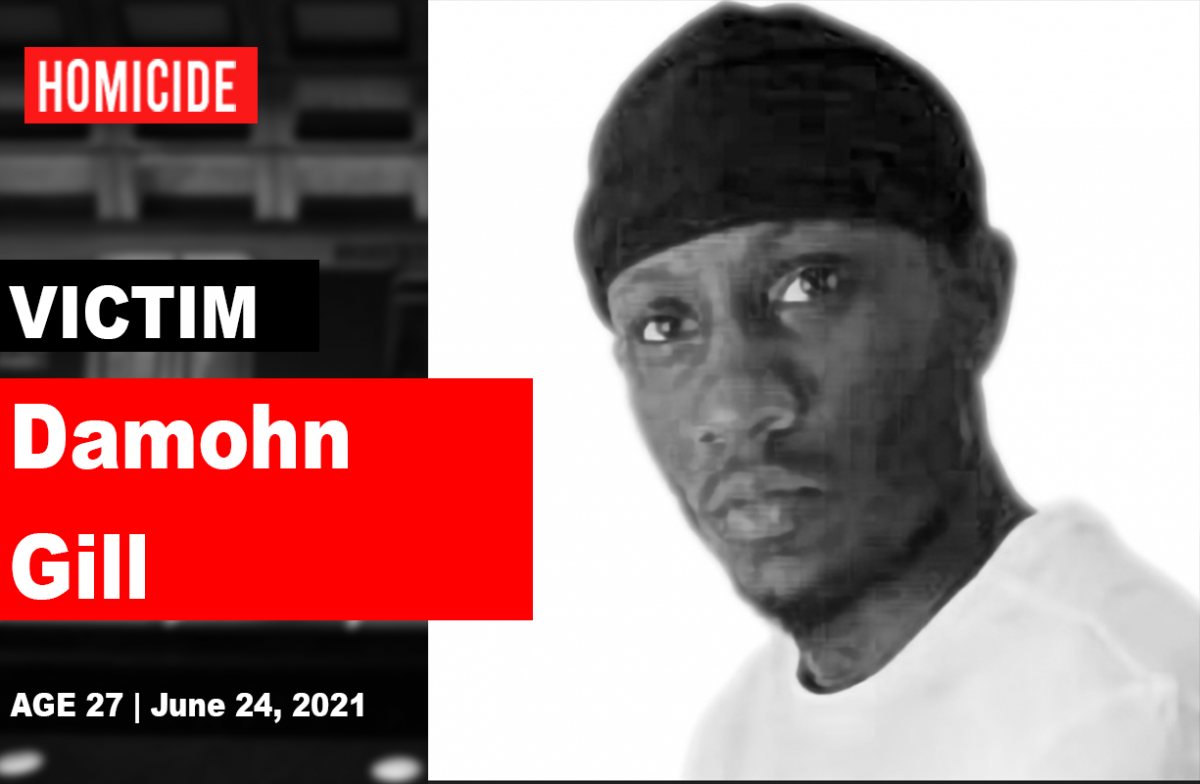
Thank you for reading D.C. Witness. Help us continue our mission into 2024.
Donate NowBy
Laura Berol
- May 22, 2024
Daily Stories
|
Homicides
|
stabbing
|
Suspects
|
Victims
|
Even though Aaron Jackson‘s alleged fatal stabbing of Damohn Gill was captured on surveillance video, the prosecution and defense offered contradictory explanations of what the jury saw take place before their eyes during closing arguments in DC Superior Court Judge Michael O’Keefe‘s courtroom on May 21.
Jackson, 30, is charged with premeditated first-degree murder while armed and carrying a dangerous weapon for his alleged involvement in the death of 27-year-old Gill on June 24, 2021, on the 3600 block of 22nd Street, SE.
The prosecution began its closing statement by replaying a video of the stabbing that had been presented as evidence earlier in the trial. The video showed individuals identified as Jackson and Gill encountering each other on the sidewalk near Jackson’s mother’s home.
“Immediately the defendant is in the [victim’s] face,” the prosecutor narrated for the jury as the video played. The prosecutor asserted that Jackson pushed Gill backwards and boxed him in with threatening movements while Gill tried to de-escalate by looking at his phone.
“His body language is consistent with someone who is calm, who is detached from whatever Aaron Jackson is trying to do,” the prosecutor said about Gill.
According to the prosecutor, Jackson’s mother saw the knife he was carrying and tried to pull him back from Gill.
“Get the f*** off me,” the prosecutor quoted Jackson as saying to his mother, based on her testimony. “His own mother–he almost stabs her, pushing her away.”
The prosecutor claimed it demonstrated premeditation and deliberation, which the charge requires–thus a key element in the case.
“There’s a point in the video where the defendant deliberates, and that’s when his mother pulls him away,” the prosecutor stated. “In this moment, he decides to kill Damohn [Gill].”
The prosecution also pointed to this moment as evidence that Jackson was not acting in self defense, based on the behavior of his mother.
“She didn’t go between Damohn [Gill] and her son,” the prosecutor observed. “She went around, which shows she thought only her son was acting unreasonably, was acting aggressively.”
The prosecutor slowed the video for that scene, but then returned it to normal speed for the stabbing itself, in which Jackson allegedly inflicted nine wounds on Gill.
“A murder in a storm of daggers,” the prosecutor called it.
Jackson’s attorney, Wole Falodun, gave a starkly antithetical account of the same events.
“What we have here is not murder,” Falodun stated. “It’s not manslaughter. What Mr. Jackson did on June 24, 2021, he was allowed by law to do.”
Falodun recalled Jackson’s testimony from May 20, in which Jackson stated that Gill had allegedly shot him in two separate instances years ago and then forbidden Jackson to return to the neighborhood where Jackson’s mother lived.
“What happened on that day did not start on June 24, 2021,” Falodun argued. “It started in 2013, and all those things were going through Mr. Jackson’s mind at that time.”
Instead of viewing Jackson as the aggressor from the start, Falodun interpreted their interactions upon meeting in the video as signs of Gill threatening Jackson.
“Mr. Jackson extends his hand,” Falodun narrated to the jury, “but Mr. Gill doesn’t respond. He leaves him hanging.”
Falodun pointed out that the surveillance video contained no audio. Drawing from Jackson’s testimony, Falodun claimed that Gill’s first words on seeing Jackson were, “What the f*** are you doing here?”
According to Falodun, based on Jackson’s testimony, Jackson then asked Gill for a pass to be back in the neighborhood, but Gill responded, “There are no passes. You’re about to die.”
“Mr. Jackson saw Mr. Gill going for his waist,” Falodun asserted, “and he pushed his mother away because he thought Mr. Gill was reaching for his gun.”
On account of the two previous shootings that Jackson allegedly suffered at the hands of Gill, Jackson saw no alternative but to defend himself against Gill with his knife, Falodun claimed.
“Mr. Jackson follows Gill because, as he told you, he knows that he cannot outrun a bullet,” Falodun explained to the jury.
“So you say, ‘Where’s the gun?'” Falodun asked the jurors. “We know people surrounded Mr. Gill after he was stabbed. We know he was a very popular person in that neighborhood. Is it possible they took the gun off Mr. Gill because they didn’t want a gun found on Mr. Gill when the police arrived?”
To decide which version of events was accurate, the prosecution urged the jury to consider the credibility of the witnesses, particularly Jackson’s mother, who testified earlier in the trial that she hadn’t seen a gun on Gill.
“It would be totally understandable if she refused to talk, if she tried to protect her son, but she didn’t. She testified because it was the right thing to do,” the prosecutor asserted. “She holds all the credibility in the world.”
Falodun, on the other hand, focused on the possibility that the jury had not received all the relevant information. He pointed out, for example, that one of the eyewitnesses had not been called to testify in the trial.
“Would he have told you that Mr. Gill was in fact threatening Mr. Jackson?” Falodun suggested to the jury.
Falodun argued that the prosecution had not met the burden of proof required for conviction–beyond a reasonable doubt–because they hadn’t proved that Gill didn’t have a gun and hadn’t threatened Jackson.
In their rebuttal, the prosecution retorted, “A reasonable doubt is based on reason. It is not based on speculation or guesswork.”
Jury deliberation began immediately after closing statements and rebuttal.
Parties will reconvene when the jury makes a ruling.
Follow this case